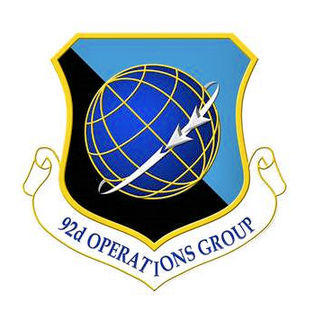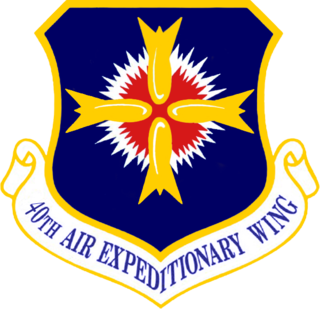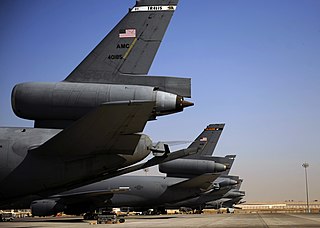This article includes a list of references, but its sources remain unclear because it has insufficient inline citations .(December 2012) (Learn how and when to remove this template message) |
22d Operations Group  | |
|---|---|
KC-135R Stratotanker taking off [note 1] | |
| Active | 1940–1952; 1991–present |
| Country | |
| Branch | |
| Part of | Air Mobility Command |
| Garrison/HQ | McConnell AFB |
| Nickname(s) | Red Raiders (World War II) |
| Motto(s) | Ducemus Latin We Lead |
| Engagements | Southwest Pacific Theater Korean War |
| Decorations | Distinguished Unit Citation Air Force Meritorious Unit Award Air Force Outstanding Unit Award Philippine Presidential Unit Citation Republic of Korea Presidential Unit Citation [1] |
| Commanders | |
| Current commander | Col Ron Langford |
| Insignia | |
| 22d Operations Group emblem [note 2] |  |
| Red Raider marking used by the 22d Bombardment Group while flying B-24s [2] |  |
The 22d Operations Group is the operational flying component of the United States Air Force 22d Air Refueling Wing. It is stationed at McConnell Air Force Base, Kansas, and is part of Air Mobility Command (AMC)'s Eighteenth Air Force.

The United States Air Force (USAF) is the aerial and space warfare service branch of the United States Armed Forces. It is one of the five branches of the United States Armed Forces, and one of the seven American uniformed services. Initially formed as a part of the United States Army on 1 August 1907, the USAF was established as a separate branch of the U.S. Armed Forces on 18 September 1947 with the passing of the National Security Act of 1947. It is the youngest branch of the U.S. Armed Forces, and the fourth in order of precedence. The USAF is the largest and most technologically advanced air force in the world. The Air Force articulates its core missions as air and space superiority, global integrated intelligence, surveillance, and reconnaissance, rapid global mobility, global strike, and command and control.

The 22d Air Refueling Wing is a United States Air Force unit assigned to the Air Mobility Command's Eighteenth Air Force. It is stationed at McConnell Air Force Base, Kansas and also functions as the host wing for McConnell.

McConnell Air Force Base is a United States Air Force base located four miles (6 km) southeast of the central business district of Wichita, a city in Sedgwick County, Kansas, United States. The airbase was named in honor of the brothers Fred and Thomas McConnell of Wichita, who had both been Air Force pilots and veterans of World War II. It is the home of Air Mobility Command's 22d Air Refueling Wing, Air Force Reserve Command's 931st Air Refueling Wing, and the Kansas Air National Guard's 184th Intelligence Wing.
Contents
- Units and mission
- History
- Origins
- World War II
- Postwar era
- Korean War
- Modern era
- Lineage
- Assignments
- Components
- Stations
- Aircraft
- See also
- References
- Bibliography
- External links
- Personal Accounts
The group's primary mission is to provide global reach by conducting air refueling and airlift where and when needed. The group directs the 22d Wing's Boeing KC-135R Stratotanker refueling and airlift operations in support of worldwide AMC, United States Transportation Command, Air Force, Department of Defense, and allied operations anywhere in the world.
A group is a military aviation unit, a component of military organization and a military formation. The terms group and wing differ significantly from one country to another, as well as between different branches of a national defence force.

An airlift is the organized delivery of supplies or personnel primarily via military transport aircraft.

The United States Transportation Command (USTRANSCOM) is one of ten unified commands of the United States Department of Defense. The command is located at Scott Air Force Base, Illinois, and was established in 1987.
During World War II, as the 22d Bombardment Group, the unit was one of the first Army Air Forces units to be deployed into the Pacific Theater after Pearl Harbor with the Martin B-26 Marauder medium bomber. It operated primarily in the Southwest Pacific Theater as a North American B-25 Mitchell unit assigned to Fifth Air Force. It was awarded two Distinguished Unit Citations and the Philippine Presidential Unit Citation for its combat service in China, the Netherlands East Indies, New Guinea, the Bismarck Archipelago; the Western Pacific; Leyte and Luzon.

World War II, also known as the Second World War, was a global war that lasted from 1939 to 1945. The vast majority of the world's countries—including all the great powers—eventually formed two opposing military alliances: the Allies and the Axis. A state of total war emerged, directly involving more than 100 million people from over 30 countries. The major participants threw their entire economic, industrial, and scientific capabilities behind the war effort, blurring the distinction between civilian and military resources. World War II was the deadliest conflict in human history, marked by 50 to 85 million fatalities, most of whom were civilians in the Soviet Union and China. It included massacres, the genocide of the Holocaust, strategic bombing, premeditated death from starvation and disease, and the only use of nuclear weapons in war.

The Martin B-26 Marauder is an American World War II twin-engined medium bomber built by the Glenn L. Martin Company in Middle River, Maryland from 1941 to 1945. First used in the Pacific Theater in early 1942, it was also used in the Mediterranean Theater and in Western Europe.

The North American B-25 Mitchell is an American twin-engine, medium bomber manufactured by North American Aviation (NAA).
The group was reactivated as part of Strategic Air Command (SAC). During the early years of the Cold War, the group moved temporarily to Okinawa in July 1950 and was attached to Far East Air Forces for duty in the Korean War. It began combat immediately, and until October 1950 attacked marshalling yards, bridges, highways, airfields, and industries and supported United Nations ground forces in Korea. It was inactivated in a SAC program to eliminate groups and assign operational squadrons directly to wings.

Strategic Air Command (SAC) was both a United States Department of Defense (DoD) Specified Command and a United States Air Force (USAF) Major Command (MAJCOM), responsible for Cold War command and control of two of the three components of the U.S. military's strategic nuclear strike forces, the so-called "nuclear triad," with SAC having control of land-based strategic bomber aircraft and intercontinental ballistic missiles or ICBMs.

The Cold War was a period of geopolitical tension between the Soviet Union with its satellite states, and the United States with its allies after World War II. A common historiography of the conflict begins with 1946, the year U.S. diplomat George F. Kennan's "Long Telegram" from Moscow cemented a U.S. foreign policy of containment of Soviet expansionism threatening strategically vital regions, and ending between the Revolutions of 1989 and the 1991 collapse of the USSR, which ended communism in Eastern Europe. The term "cold" is used because there was no large-scale fighting directly between the two sides, but they each supported major regional conflicts known as proxy wars.

The Korean War was a war between North Korea and South Korea. The war began on 25 June 1950 when North Korea invaded South Korea following a series of clashes along the border.






























